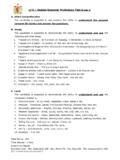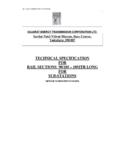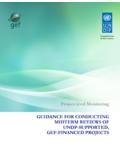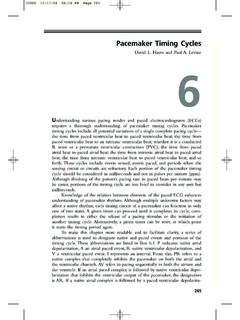Transcription of DID ASYMMETRIC MOBILE TERMINATION RATES HELP …
1 1 DID ASYMMETRIC MOBILE TERMINATION RATES help ENTRANTS GAIN MARKET SHARE? J. Gregory Sidak,* Andrew P. Vassallo & Leonard Sabetti ABSTRACT Regulators in many countries have asserted that setting ASYMMETRIC MOBILE TERMINATION RATES (MTRs) between the incumbent MOBILE telephony operator and its smaller rivals is an efficacious means by which to help entrants attain efficient scale. We investigate empirically the efficacy of this policy experiment using data from a global sample of 34 countries from 1996 through 2014. We estimate a model that relates operators long-run market shares to initial entry conditions and the degree of asymmetry among MTRs using an instrumental variables (IV) strategy. The estimates imply that a high degree of asymmetry among MTRs lowers an entrant s long-run market share by roughly 4 percentage points compared with a regime of symmetric MTRs, and the effect is roughly constant across market penetration levels.
2 Furthermore, MOBILE operators tend to perform better when entering markets with higher levels of concentration and lower levels of market penetration. Our novel findings cast doubt on the efficacy of imposing ASYMMETRIC MTRs as a means to achieve greater equality of competitive outcomes. Our findings inform the larger body of theoretical literature on the pricing of interconnection and network access. JEL: D43; K23; L13; L96 I. INTRODUCTION When a MOBILE subscriber calls another person who subscribes to a competing MOBILE network, the receiving network typically charges the originating network operator an interconnection rate, called a MOBILE TERMINATION rate (MTR), to terminate the call on the receiving network. Although there exist different policies for MTRs, the majority of countries use the calling party network pays (CPNP) model in the wholesale market.
3 By contrast, the United States, Canada, and Hong Kong rely on a system of bill and keep, whereby calls are terminated on a competing network without a financial settlement, which is equivalent to charging MTRs of zero. This arrangement is voluntary and not due to regulatory intervention. The pricing of network interconnection has drawn scrutiny from regulators around the world due to the allegation that market failure exists for terminating voice calls under CPNP, both in the fixed-to- MOBILE and MOBILE -to- MOBILE segments. According to a 2012 report by the Organisation for Economic Co-operation and Development (OECD), because every MOBILE operator supposedly has a monopoly over TERMINATION of calls on its own network, a MOBILE operator may set MTRs above its cost to extract rents from its Because of this concern, regulators began setting MTRs based on cost models.
4 For example, many countries, such as Germany and the United Kingdom, rely on a version of long-run incremental cost (LRIC) to set MTRs. One of us has argued previously that it was unrealistic for regulators to set TERMINATION RATES at marginal Competitive forces constrain an operator s market power in the pricing of TERMINATION RATES , and exogenous price controls are unlikely to be socially With regulated interconnection RATES , certain questions emerged. If MOBILE operators have different cost structures, should they each be charging separate RATES based on their respective cost structures? Should those RATES depend on the stage of each operator s development? In light of such questions, * Chairman, Criterion Economics, , Washington, Email: Assistant Professor, Shippensburg University.
5 Email: Consultant, Criterion Economics, Washington, Email: The authors thank Lai Jiang for helpful comments. The Authors (2015). All Rights Reserved. 1 See Organisation for Economic Co-operation and Development (OECD), Developments in MOBILE TERMINATION 2 (OECD Digital Economy Papers, No. 193, Feb. 28, 2012), available at 2 Robert W. Crandall & J. Gregory Sidak, Should Regulators Set RATES to Terminate Calls on MOBILE Networks?, 21 YALE J. ON REG. 261, 297 (2004). 3 Id. at 287. December 1, 2015 J. Gregory Sidak, Andrew P. Vassallo & Leonard Sabetti 2 some regulators opted to impose ASYMMETRIC MTRs for incumbent or larger operators. ASYMMETRIC MTRs mandated that those larger operators charge lower RATES for terminating calls on their networks compared with the RATES charged by smaller operators or entrants, with size measured by the share of subscribers within a country.
6 Smaller operators or operators that had entered the market later thus received preferential RATES . Other regulators in a number of countries have instead opted to impose symmetric MTRs, by which all operators charge the same MTRs. A number of European countries adopted ASYMMETRIC MTRs with the primary justification being to assist entrants in competition with Regulators in these countries generally implemented ASYMMETRIC MTRs shortly following entry of a MOBILE operator in nations that previously had two or three operators. Although there has generally not been a consensus in approach across national regulatory authorities (NRAs), the European Commission issued guidelines in 2009 on the setting of MTRs. These guidelines reiterate the importance of symmetric RATES based on cost models, with allowances for exogenous cost differences across carriers.
7 They also grant ASYMMETRIC RATES for new entrants for a transitional period of up to four years upon According to the Commission, roughly four years is an adequate period by which an entrant can achieve a minimum efficient scale, characterized by a market share of between 15 and 20 At the same time, in a number of other countries either MTRs were voluntarily symmetric or symmetry was a result of policy. In light of the policy experiment of setting ASYMMETRIC MTRs, a natural question arises. To what extent have entrants under ASYMMETRIC MTRs performed better than entrants under symmetric MTRs? By assessing the global experience with ASYMMETRIC MTRs, we examine whether ASYMMETRIC MTR regulation has actually improved the market position of later entrants, relative to incumbents in the MOBILE telecommunications industry.
8 To the best of our knowledge, this is the first empirical study of the impact of ASYMMETRIC MTR regulation on entrant performance on a retrospective basis. (By contrast, most studies examine the impact of ASYMMETRIC MTRs on MOBILE prices, as we discuss in Part II.) We use a sample of 38 MOBILE operators, most of which entered the market from 1998 through 2003, when the MOBILE industry was growing rapidly. Our main finding is that the impact of ASYMMETRIC MTRs on entrants gain in market share has not been significant from either a statistical or an economic perspective. In Part II, we review the arguments for and against ASYMMETRIC MTRs. In Part III, we evaluate the impact of ASYMMETRIC MTRs on the long-run competitive position of entrants. In Part IV, we provide perspectives on how the experience of MTR regulation in the MOBILE market may help shape future policy.
9 II. JUSTIFICATIONS FOR ASYMMETRIC MTRS IN THE ECONOMIC LITERATURE The economic literature has emphasized rival theories about the effects of setting various levels of MOBILE TERMINATION RATES on prices and competition. Although no consensus exists among policymakers about what the optimal TERMINATION rate might be, there seems to be a dominant view that regulating MOBILE TERMINATION RATES is an important means of promoting competition in telephony. Because each network provider controls access to its own network, the argument is that MOBILE TERMINATION RATES set by operators would necessarily be monopolistic and anticompetitive. According to the European Commission Recommendation, excessively high levels of TERMINATION RATES are the main concern of regulatory authorities, and consequently mandating the cost orientation of interconnection access is the most appropriate policy In this part, we provide an overview of the rival theories surrounding this policy issue.
10 4 See European Commission (EC), Explanatory Note, Commission Staff Working Document, Accompanying the Commission Recommendation on the Regulatory Treatment of Fixed and MOBILE TERMINATION RATES in the EU 5 (2009), available at 5 See European Commission (EC), Recommendation on the Regulatory Treatment of Fixed and MOBILE TERMINATION RATES in the EU 69 (May 2009) [hereinafter EC Recommendation on MTRs], available at :L:2009:124:0067:0074:EN:PDF. 6 Id. 7 EC Recommendation on MTRs, supra note 5, at 68. Did ASYMMETRIC MTRs Assist Entrants? 3 A. The Cost-Disadvantage Justification One justification given for implementing ASYMMETRIC MTRs is that it helps entrants reach sufficient scale to compete with the In an industry with high fixed costs and low marginal costs, even if all firms are equally efficient, the firm with the greatest market share will have the lowest average cost.








